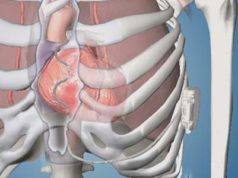![]() New guidelines for the management of patients with ventricular arrhythmias and the prevention of sudden cardiac death have been published today in the European Heart Journal and call for more automated external defibrillators (AEDs) to be placed in public spaces such as shopping centres, stadiums, and railway stations.
New guidelines for the management of patients with ventricular arrhythmias and the prevention of sudden cardiac death have been published today in the European Heart Journal and call for more automated external defibrillators (AEDs) to be placed in public spaces such as shopping centres, stadiums, and railway stations.
The updated guidance from the European Society of Cardiology (ESC), launched on day one of the society’s annual congress (ESC 2022; 26–29 August, Barcelona, Spain), also suggests that basic life support training in schools and communities is essential to improve survival from cardiac arrest.
“The public is our major ally in the battle against sudden cardiac death in communities,” said guidelines task force chairperson Jacob Tfelt-Hansen (Copenhagen University Hospital, Copenhagen, Denmark). “Everyone, including schoolchildren, should learn how to do cardiopulmonary resuscitation (CPR) and use an AED. Both of these actions can save lives.”
“Going one step further, emergency services should consider adopting mobile phone systems to locate and activate volunteers near to victims, allowing early resuscitation attempts before the arrival of paramedics,” said guidelines task force chairperson Katja Zeppenfeld (Leiden University Medical Centre, Leiden, The Netherlands).
In the Western world, 75–80% of sudden cardiac deaths are caused by coronary artery disease. Risk can be reduced by adopting heart healthy habits such as not smoking, consuming a nutritious diet, losing excess weight, exercising and reducing stress—all of which help to avoid plaque build-up and clot formation in the coronary arteries, ESC said in a press release.
For heart attack patients, revascularisation to open the blocked coronary artery reduces the risk of ventricular arrhythmias and sudden cardiac death, the press release notes, adding that it also helps to preserve cardiac function by restoring normal circulation to the heart muscle.
After revascularisation, which can be achieved with percutaneous coronary interventions (PCI) or coronary artery bypass graft (CABG), the most important factor associated with the occurrence of sudden cardiac death is the remaining function in the left ventricle.
Tfelt-Hansen said: “Patients with a myocardial infarction or chronic coronary artery disease who have severely reduced left ventricular function and symptoms of heart failure despite revascularisation and medication are at risk of sudden cardiac death and an implantable cardioverter defibrillator is indicated.”
Sudden cardiac death can also be caused by electrical disorders of the heart. Patients with diagnosed conditions that increase the likelihood of sudden cardiac arrest must avoid the specific triggers related to their disease. For example, those with a rare electrical disorder called catecholaminergic polymorphic ventricular tachycardia (CPVT) should steer clear of competitive and strenuous exercise and stressful environments. Disease- and patient-specific lifestyle adjustments should be discussed with the treating cardiologist.












